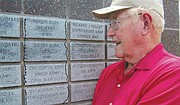In 1803, the United States more than doubled its size with the Louisiana Purchase. The following year, what would one day become the state of Missouri was divided into four districts. On Oct. 1, 1812, the area was reorganized into five counties and named the Missouri Territory.
Although a few changes took place in the territory between 1813-15, the biggest change occurred Jan. 23, 1816, with the organization of Howard County. Named after Benjamin Howard, the first governor of the Missouri Territory, Howard County covered more than one-third of the state. It reached all the way to what would become Kansas and Iowa. Howard County would eventually form all or parts of 39 additional counties. Boonville, which was south of the Missouri River across from Franklin, was the county seat.
As the population increased south of the river, people began requesting Howard be made into two counties, one on each side of the Missouri River. Finally, after less than three years, Howard was divided. On Dec. 17, 1818, everything north of the river remained Howard County, and everything south of the river became Cooper County, which was named after Sarshel Benjamin Cooper, an early settler to the area.
The one drawback to the division was the county seat. Boonville was Howard County's seat of government, but it was on the wrong side of the river. Laid out in 1823, Fayette became Howard County's seat. The town was named after Gilbert du Motier, Marquis de Lafayette.
It should be noted many prominent people were born in Howard County. Two of them were Frank P. Briggs and Talbot Smith.
Frank P. Briggs was born in Armstrong on Feb. 25, 1894. He served as a Missouri State Senator from 1933-1944. In 1944, he was appointed U.S. senator to replace Harry S Truman when Truman was elected vice president of the U.S. Briggs served from Jan. 18, 1945, to Jan. 3, 1947. From 1961-65, Briggs was U.S. assistant secretary of the interior for fish and wildlife. He died Sept. 23, 1992.
Talbot Smith was born Oct. 11, 1899, in Fayette. He was an associate justice of Michigan's Supreme Court from 1955-61. On Oct. 5, 1961, Talbot was President John F. Kennedy's recess appointment for federal judge of U.S. District Court for the Eastern District of Michigan. He was confirmed by the Senate on Feb. 5, 1962, and assumed senior status Oct. 31, 1971. Talbot served until his death on Dec. 21, 1978.
Elizabeth Davis was born and raised in Cooper County, Missouri, and has written Historically Yours for the Boonville Daily News for over 10 years. She has covered the Civil War, U.S. history and Cooper County history. In celebration of Missouri's Bicentennial, she has syndicated her column statewide and encourages readers all over the Show-Me State to submit topic suggestions for future columns to [email protected].

